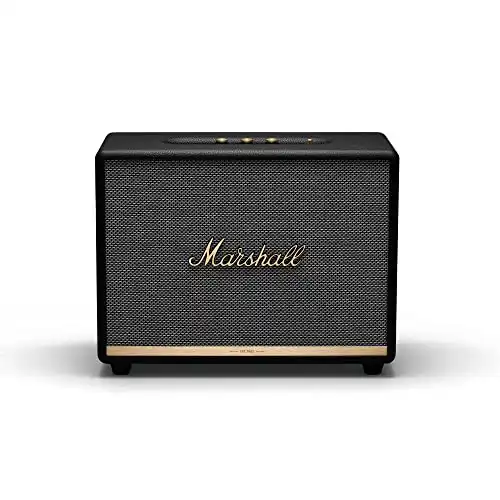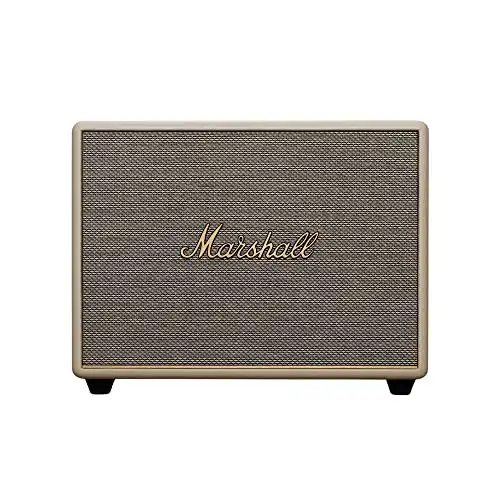Marshall is no stranger to audio equipment and has been at the forefront of the speaker and amp industry for decades. In recent years the audio giant has shifted its gears towards more modern products like Bluetooth speakers and portable speakers.
One of the more popular models they have introduced recently is the Marshall Woburn line of speakers, which have received almost universally positive reviews. For consumers struggling to narrow down their choice to either the Woburn 2 or Woburn 3 – this article is going to examine everything about these speakers, down to the material used to cover them.
If you want a more concise summary of what goes into each of these speakers, we offer a quick comparison below that bullet points the pros and cons of each device.
~~~ Check Price: Marshall Woburn 2 ~~~
~~~ Check Price: Marshall Woburn 3 ~~~
Quick Comparison
There seems to be a slight variation in focus when Marshall decided to work on these speakers. If you are someone who enjoys the deafening feeling of your eardrums losing their faculties – the Woburn 2 is likely more your speed. If you want something a bit more eco-friendly, with a larger soundstage and additional features, the Woburn 3 is going to be your best bet.
|
|
|
|
$180.74
|
N/A
|
The Woburn 2 comes with a lot of power packed into a lower price. Not only do you get a powerful decibel level of 110, but this Marshall device also comes with great audio quality, and a product that is designed as beautifully as a speaker could be.
While it doesn’t offer all the features you would find on similarly priced products, if you are a fan of vintage Marshall amplifiers the Woburn 2 is an exceptionally well-made Bluetooth speaker.
The Woburn 3 is the slightly more expensive option at an MSRP of $580 though it comes with notable upgrades that are worth a second glance. The material is designed with a focus on recyclable materials, you get additional inputs and top panel controls as well as audio that touches every inch of its immediate surroundings.
If the max volume isn’t a deciding factor and you want a speaker that offers a few additional options and the same audio quality Marshall has become famous for – the Woburn 3 might be worth the added cost.
Sound Quality
It can prove difficult when measuring the abilities of two speakers that were designed roughly the same due to a minimal amount of difference. Due to this, we will try to cover what each product shares with the other while still covering what separates the two. If you are someone who wants a speaker that is good at being a speaker – there is nothing more important than its sound quality.
The Woburn 2 might be the size of some of the other speakers today, though it offers a sound that feels like it belongs to a much beefier product. The Woburn 2 has incredible audio clarity that is felt even in the low bass (which is as palpable as you will find from a speaker this size). You get a maximum decibel level of 110 as well so you never have to worry about the speaker being drowned out.
One thing several fans of vintage equipment will enjoy is Marshall’s focus on keeping its products simple – you can adjust the treble and bass via the dials on the speaker or via an equalizer through the Marshall app. With these settings left untouched, the speaker will deliver a cozy, clear sound that is sure to impress anyone in earshot.
The second generation Woburn comes with a frequency range of 30Hz – 20kHz and offers two 50-watt class D amps for the woofer as well as two 15-watt amps for the tweeters. To the surprise of no one, you can also play this impressive Marshall speaker in stereo.
The Woburn 3 matches its predecessor in a lot of different categories, though falls slightly behind when it comes to its ability to replicate the sound. While the product does get loud, it falls a bit behind the second generation at 100.5 decibels. It does offer all the analog controls its previous model does as well as an in-app equalizer so you have plenty of different ways to adjust the music to your preference.
The frequency response of this product is 35Hz – 20 kHz which is only a tad behind the Woburn 2 – though it does fall short. It should be said that the soundstage is audibly better on the 3 which can be understood when looking underneath the hood. Internally this speaker offers a 90-watt class D amp for the bass speaker, two 15-watt class d amps for the midrange speakers, and two 15-watt class D amps for the tweeters. It does also play music in stereo, which feels required for any speaker in this price range.
Verdict – While it is fairly close, the Woburn 2 has more to offer in terms of audio.
Design
One thing folks can never say about Marshall is that their speakers are ugly. The Marshall Woburn, Stanmore, and Acton speakers are all brilliantly made and a pleasure to behold. The material feels luxurious and resilient while also being comfortable to the touch and the exterior of the speaker looks like it was meant for the edge of a stage.
These speakers are not powered by batteries or meant for the outdoors. Because of this, they offer no protection against water and should avoid contact with liquids. If you want an outdoor speaker – check out our comparison article on the Sony XP700, Soundboks Go, and JBL Partybox 310.
The Woburn 2 comes in three distinct color patterns; black, white, and brown. Outside of the covering, all three styles utilize the same gold trim and lettering on raised aluminum. The encasing feels like a good imitation of leather with a metallic grille wrapped snugly into the front of the device. The guitar amp inspiration is obvious when looking at the top panel which has very snug, control knobs that are a dead ringer for the user panel of a Marshall MG15GR.
Moving to the dimensions of the second-generation Woburn, it is one of the heftier Bluetooth speakers you are going to find. It weighs in at 18.85 lbs, 2.43 lbs more than the Woburn 3. It measures out to 15.75 x 12.20 x 7.87 inches, so while it is bulky – you shouldn’t have an issue carrying it around.
The Woburn 3 offers a bit less in terms of color with only Black and Cream, though both are well-made and would easily fit in the background of an office or workspace.
Marshall has made a point to make the materials used more sustainable, though it is hard to notice much difference from the previous iteration. The top panel is the familiar miniature guitar panel design that Marshall has smartly chosen for most of their portable products. Speaking strictly on visuals, outside of a few additional buttons and ports – these products are virtually identical.
The 3rd generation has managed to slim down a few pounds, weighing in at 16.42 pounds and taking up 15.75 x 12.48 x 7.99 inches of room. If the heftiness of the 2nd model is a concern, the lighter design of the Woburn 3 could be preferable. You also get the added benefit of purchasing something that is at least advertised to be more environmentally friendly.
Verdict – The Woburn 3 is a bit lighter, but both are too similar to choose a definitive winner. They are great-looking speakers if the style is appealing to you.
Features & Software
If these Marshall speakers suffer from anything – it is a noticeable lack of modern features. Unlike other speakers on the market today, Marshall has emphasized their Woburn, Stanmore, and Acton models’ vintage and old-school aesthetic.
This makes their design pop out beautifully and creates a simplistic menu that still offers a good amount of customization. It does take away from other features that would have been nice, however.
The Woburn 2 is a beautiful piece of equipment, though it is fairly straightforward. On the top panel menu you get a number of different control options; volume, bass, and treble control knobs, a play/pause button, a stylish power switch, and a source button. The app offers further sound customization should you choose to adjust it.
As far as inputs you get the choice of an RCA and 3.5mm inputs. While the speaker may look like it belongs in the background of a rock concert – it does not offer compatibility with electric instruments, unfortunately. The Woburn 2 has BlueTooth 5.0 compatibility as well which has a range of about 30 feet. Dual speaker functionality is offered via Bluetooth or with the inputs previously listed.
The Woburn 3 has added a tiny bit more to its user interface and features than the second generation offered. Its top panel menu comes with a volume, bass, and treble control knob, power lever, play/pause, and a source button. They have also introduced a skip control that allows you to go back or forward on a playlist. Sound customization is accessible through the top panel menu or in the Marshall Bluetooth app.
For inputs, you have the RCA and 3.5mm inputs that the second generation had – with an additional HDMI input should you require one. Bluetooth has been bumped up to 5.2 with a range of 30 feet and dual functionality is easily accessible through a Bluetooth or wired connection. While neither has the futuristic aspects we have come to expect from Bluetooth speakers, these Marshall Woburns offer all the essentials while staying true to the vintage design.
To put it bluntly, The Marshall Bluetooth app is pretty poorly reviewed (2.6 & 1.7 on Google Play and the App Store) and difficult to work with. Thankfully it serves very little purpose outside of sound customization – which can also be tweaked via the top panel – and software updates. Just know that the initial setup with these apps has been reported to be incredibly difficult and time-consuming for some.
Verdict – The Woburn 3 offers an HDMI input and a Skip button, technically making it superior in this category. Realistically, both products operate about the same when it comes to what they additionally come equipped with.
Conclusion
While it may seem on the surface that the three would be the superior speaker, that is not actually the case. Both speakers perform remarkably well for their size and offer quite a bit, though what you want from them largely depends on you.
The Woburn 2 has a bit more bark and can sneak a bit lower on the frequency range while also offering more color options. The 3rd generation comes with a few pounds shaved off of it, upgraded Bluetooth, improved soundstage, and additional features and inputs.
|
|
|
|
$180.74
|
N/A
|
So which speaker would we recommend? If the hefty price of both is no concern, either is excellent. To make the decision easier – choose the Woburn 2 for Sound Quality and choose the Woburn 3 for more input options, features, and slightly lighter weight.


